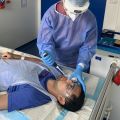New research provides compelling evidence of the connection between AMR surgical-site infections and arthropods
30 September 2021
Antimicrobial resistance (AMR), the resistance of micro-organisms to antibiotics, antivirals or antifungals, is a huge global problem. Left unchecked, AMR threatens to become one of the world’s biggest health problems, surpassing diabetes and cancer. As more bugs become drug resistant we will lose the ability to rely on antibiotics for routinely treatments - including for basic surgery, cancer treatments or caesareans.
AMR could render many of the current mainstay and last-resort antibiotics useless, resulting in many more deaths from previously treatable infections. In 2019, a UN report estimated that drug-resistant microbes could lead to ten million deaths per year, and cost the world $100trn, by 2050.
Today, Oxford academics at the Ineos Oxford Institute (IOI), in partnership with other UK colleagues and collaborators in Peshawar, northern Pakistan, have published an article in Nature Microbiology, that for the first time, provides compelling evidence of connections between AMR bacteria causing surgical-site infections and arthropods. Key findings include:
- Approx. 20% of the flies, cockroaches, spiders, moths, and ants were carrying carbapenem resistance - a drug reserved for life-threaten infections.
- And 70-80% were carrying extended spectrum cephalosporin resistance - enzymes that confer resistance to most beta-lactam antibiotics, including penicillins, cephalosporins, and the monobactam aztreonam.
- Currently there are approximately 18 million flies to every human, but conservative global warming projections estimate insect and fly population will double if temperatures increase by 1.5 degrees.
- By 2080 there could be approx. 50,000 trillion flies carrying carbapenem resistance and spreading AMR across the planet.
‘Similar to our experience over the last eighteen months with the pandemic, a problem currently seen from afar will quickly come into focus much closer to home. The clinical burden of AMR is most felt in low-middle income countries, but the increase in global temperatures, due to climate change, will result in a significant increase in flies and many other insects and a subsequent increase in the global velocity of antibiotic resistance.’ Prof. Tim Walsh, Oxford University
The pressing issues of AMR are not isolated to the ward or clinic but are far broader and aligned with anthropological behaviour, dealing with human and animal waste and even climate change. Resistance can spread within hospitals, communities, farms, and wastewater systems - and we already know that domestic and companion animals share AMR microorganisms with humans.
One option that would delay, but not solve our problem, is to repurpose previously developed drugs - that either did not work in humans or that did not pass rigorous safety regulations - and using these instead in animals. This might slow the rate at which bacteria evolve to evade our current antibiotics, buying time to develop new ones.
Rethinking hospitals prevention and infection control measures, particularly in lower- and middle-income countries, is also part of the answer. As is further research into understand the impact of arthropods on the dissemination of AMR and improving the basic healthcare infrastructure to mitigate the spread of AMR by arthropods.
‘There is no silver bullet when it comes tackling the worldwide threat of AMR. The Ineos Oxford Institute for AMR Research is committed to finding non-human antibiotic therapies and feeds for animals, addressing the increase in AMR in human infections and raising awareness of this hidden threat to human health. But this is a global medical crisis that ultimately will only be resolved with a global response.’ Prof. Tim Walsh, Oxford University.
Notes to Editor
Full paper: https://rdcu.be/cyxtI
Nature Microbiology editorial - https://www.nature.com/articles/s41564-021-00977-x
Nature Microbiology October 2021 - https://www.nature.com/nmicrobiol/volumes/6/issues/10
Methodology
Combine patient demographics, sample collection across two seasons and in-depth bacterial genomics analyses - using an observational, longitudinal study design - and collected data from ants, spiders, cockroaches, moths, flies, patients and hospital surfaces.
For interviews or other requests, please contact:
Rob Ashley, Strategic Communication, Oxford University
[email protected]
Professor Tim Walsh, Professor of Medical Microbiology, Oxford University
[email protected]
About the University of Oxford
Oxford University has been placed number 1 in the Times Higher Education World University Rankings for the sixth year running, and at the heart of this success is our ground-breaking research and innovation.
Oxford is world-famous for research excellence and home to some of the most talented people from across the globe. Our work helps the lives of millions, solving real-world problems through a huge network of partnerships and collaborations. The breadth and interdisciplinary nature of our research sparks imaginative and inventive insights and solutions.
Through its research commercialisation arm, Oxford University Innovation, Oxford is the highest university patent filer in the UK and is ranked first in the UK for university spinouts, having created more than 200 new companies since 1988. Over a third of these companies have been created in the past three years.
 Ground-breaking study reveals how COVID-19 vaccines prevent severe disease
Ground-breaking study reveals how COVID-19 vaccines prevent severe disease
 Novel triple drug combination effective against antibiotic-resistant bacteria
Novel triple drug combination effective against antibiotic-resistant bacteria
 Researchers discover how immune cells hunt down cancer around the body
Researchers discover how immune cells hunt down cancer around the body
 New algorithm supercharges climate models and could lead to better predictions of future climate change
New algorithm supercharges climate models and could lead to better predictions of future climate change
 New study to improve vaccines and therapeutics development
New study to improve vaccines and therapeutics development